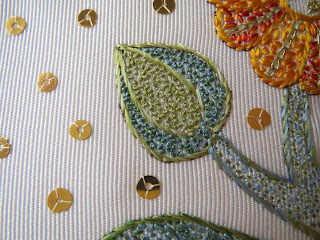The Bacton Altar Cloth is a heavily embroidered cloth of silk and silver that is believed to have possibly once belonged to Queen Elizabeth I. At some point in its life, it was cut and pieced to form a cover for a small table or alter, most likely after it was donated to the parish church of St. Faith, Bacton. Prior to 2015, when the BAC was removed from display, it was hung in a frame on the north wall of the church for 106 years. After extensive conservation, the embroidery went on display at Hampton Court Palace. The BAC Research Group were able to view and photograph the cloth in detail while the cloth was undergoing conservation and on display.
By studying their own images and examining contemporary printed sources, the group aim to independently categorize and interpret the motifs. In the lecture, they shared their observations, unanswered questions, and evolving understanding of the cloth. Members of the group have also attempted to recreate some of the botanical motifs. Our fourth sample was based on a marigold on the cloth.
The fabric for this sample is a gorgeous ribbed silk called faille. While I loved the fabric, it did cause me some problems later on. Once again, the design was transferred using the prick and pounce method.
For all outlines, I used a combination of two colours, two strands of each. I started with stem stitch, i.e., a ‘/’ diagonal stitch and intended to use this throughout but switched to a ‘\’ diagonal stitch when stitching the lefthand side of the petals.
The stem, leaf, and flowers are filled with various seeding techniques.
For the stem, I used seed stitch with four strands of silk. I tried to keep the stitches as small and consistent in size with approximately a stitch size space between each. I tried to make placement and stitch direction random but found it difficult to ignore the obvious weft threads in the fabric. My ‘method’ for random seeding is to make one stitch in a space and then place six stitches around the first stitch in a vaguely hexagonal shape. For each pair of stitches in the hexagon, I place a third stitch to make a more or less equilateral triangle. I continue to make every pair of stitches into a triangle. I vary the angle of each stitch by angling them more or less towards the centre of the triangle. I use an additional filling stitch any time I think the spacing is increasing, or miss a stitch if I think they are becoming too close.
© Cynthia Jackson/Carol-Anne Conway
I used double seed stitch in the leaf, again four strands of silk. I stitched one stitch directly over the other. As this made each stitch slightly larger, I spaced the first slightly further apart than for the single seed stitches. I found this much more difficult to keep consistent than single seed stitch. If I do this again, I will try placing the second stitch at a slight angle to the first.
© Cynthia Jackson/Carol-Anne Conway
For the bud, I used seeded knots. I made a soft 'S' 4 -> 1 twist. Throughout, I have used a combination of two colours in the needle. For these twisted threads, I used 1 strand of each colour on each ply.
© Cynthia Jackson/Carol-Anne Conway
The calyx is also filled with seeded knots but here I twisted 2 ->1 using one ply of each colour. At first, I double-spaced the knots but I thought they were too far apart so I filled in a little.
© Cynthia Jackson/Carol-Anne Conway
The petals of the flower are worked in single seed stitch, eight strands of silk, four of each colour. I hoped eight strands, closely seeded would give more saturated colour to the petals, which it has. I think the larger, fuller stitches also have more shine on the silk, which I like.
© Cynthia Jackson/Carol-Anne Conway
This was great fun to stitch! It was somewhat time-consuming but once I got into the rhythm of stitching randomly, it required less precision than something like satin stitch. I enjoyed doing the seeded knots and like how they look but they were even more time-consuming. I wanted to try different options and see how each looked. It is interesting to see the different textures and effects of each.
Happy Stitching






1 comment:
Random stitching is really difficult, isn't it! I think you've done a great job.
Post a Comment